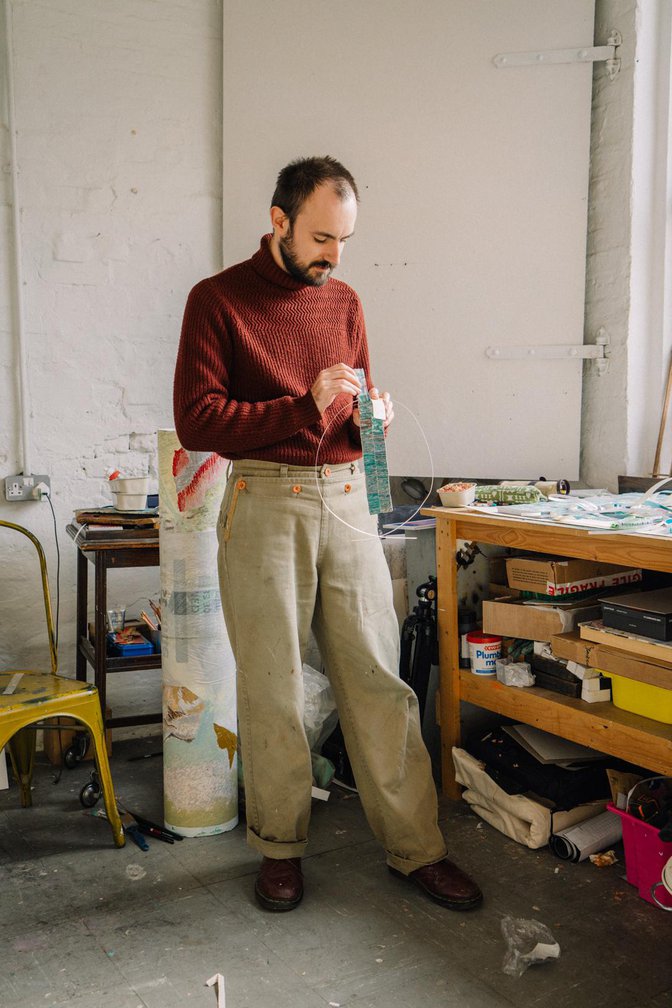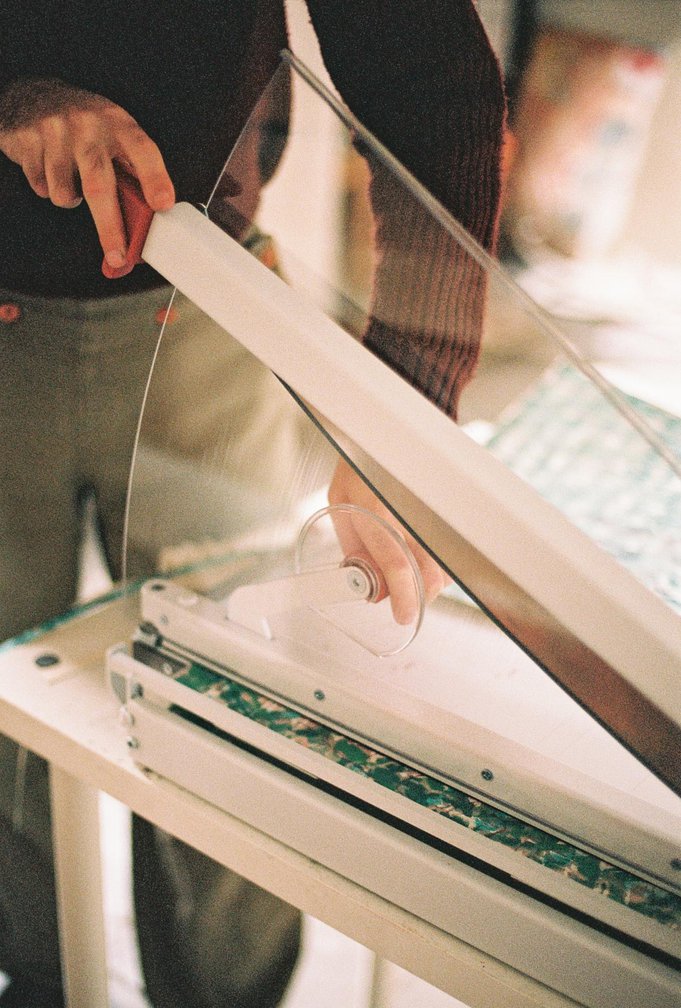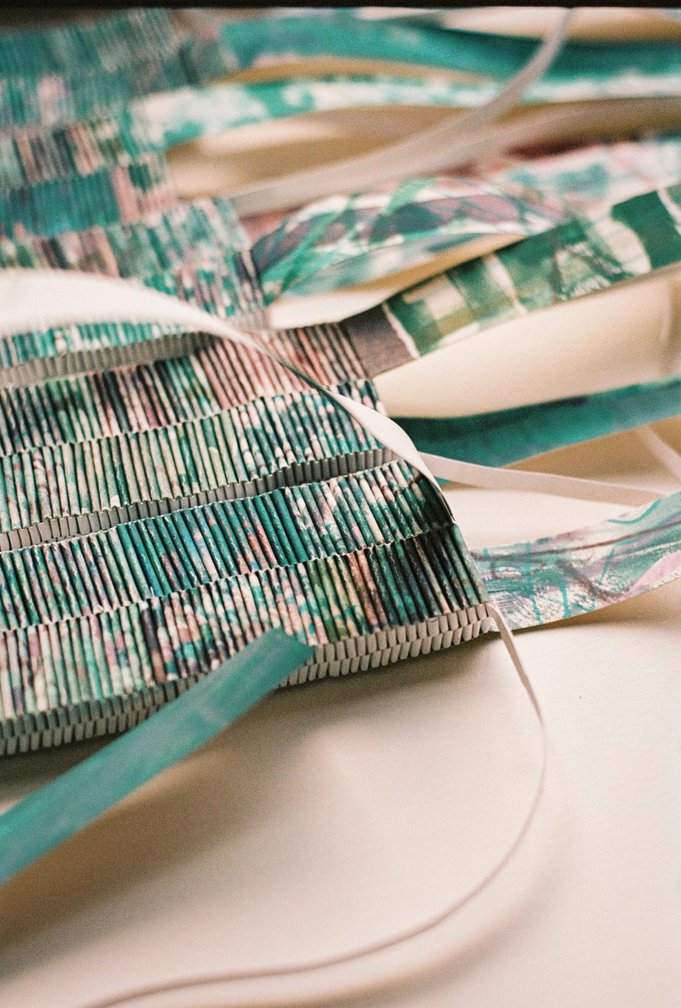article In conversation with
Euan Evans
In conversation with
Euan Evans
Euan Evans

In conversation with Euan Evans
about the serendipity of objects
and the big impact of small stories.
about the serendipity of objects
and the big impact of small stories.
In conversation with Euan Evans
about the serendipity of objects
and the big impact of small stories.
Euan Evans is a Cornish-born, London-based artist who recently completed his MA at the Royal College of Art. Having previously studied Jazz at Leeds Conservatoire, Evans explores the interactions between improvisation, texture, and composition through various visual inquiries. Incorporating elements of drawing, printmaking and sculpture, Evans’ work finds agency through the interplay of substrates and colour.


Artiq When did you first decide that you wanted to become an artist?
Euan I'm not sure when I decided to become an artist. I enjoyed drawing and creating things from found materials around the house when I was younger. My family were very supportive, and it progressed from there. After several years of studying art and exhibiting work, I now consider myself an artist. But my journey to this point was a series of much smaller questions about making.
Artiq In what ways do your artworks draw inspiration from your upbringing in the Cornish
landscape?
Euan I like to make work about first-hand experiences. I used to make journals like diaries about the day-to-day, making images of people and places. More recently my work continues the same topic but using materials or methods that specifically reflect a time or place. I feel motivated to talk about small stories in my work; things that are not of any particular consequence but make you feel attached to a time or a place. My dad and I were planting vegetables in the garden when we dug up half of a mould for a plumb weight. A few years later, we found the other half of the mould in the wall of the house, and we thought, 'How funny is that?!' It's these things that inspire me.
Euan I'm not sure when I decided to become an artist. I enjoyed drawing and creating things from found materials around the house when I was younger. My family were very supportive, and it progressed from there. After several years of studying art and exhibiting work, I now consider myself an artist. But my journey to this point was a series of much smaller questions about making.
Artiq In what ways do your artworks draw inspiration from your upbringing in the Cornish
landscape?
Euan I like to make work about first-hand experiences. I used to make journals like diaries about the day-to-day, making images of people and places. More recently my work continues the same topic but using materials or methods that specifically reflect a time or place. I feel motivated to talk about small stories in my work; things that are not of any particular consequence but make you feel attached to a time or a place. My dad and I were planting vegetables in the garden when we dug up half of a mould for a plumb weight. A few years later, we found the other half of the mould in the wall of the house, and we thought, 'How funny is that?!' It's these things that inspire me.

Artiq Could you elaborate on the significance of scrap copper and incorporating objects from your home in your artwork? How do these elements contribute to the narratives within your pieces?
Euan Last year, I created a series of artworks using my parents' old copper water tank from their cottage. Our house is situated near the abandoned South Caradon copper mine, and this has a significant impact on the landscape. My dad worked as a copper smith at Portsmouth Dockyard and taught me how to manipulate copper into different forms. I wanted to use the copper as more than just a plate for printing, it has an important role in reflecting my family and where I live.
I have used some objects, such as a very old wooden cramp, to squeeze and shape the woven paper. However, the cramp is a tool I use for carpentry, and it belongs in my shed at home. I find these artworks and objects playful rather than sentimental, using the items directly around me to create something beyond their original purpose.
Euan Last year, I created a series of artworks using my parents' old copper water tank from their cottage. Our house is situated near the abandoned South Caradon copper mine, and this has a significant impact on the landscape. My dad worked as a copper smith at Portsmouth Dockyard and taught me how to manipulate copper into different forms. I wanted to use the copper as more than just a plate for printing, it has an important role in reflecting my family and where I live.
I have used some objects, such as a very old wooden cramp, to squeeze and shape the woven paper. However, the cramp is a tool I use for carpentry, and it belongs in my shed at home. I find these artworks and objects playful rather than sentimental, using the items directly around me to create something beyond their original purpose.

Artiq What role does the process of weaving play in your artistic practice, particularly its connection to your childhood knotcraft experiences?
Euan I have been interested in process-based ways of making surfaces for the past few years. During my studies in London, my tutors took me to the Sainsbury Wing at the National Gallery, where I was fascinated by the laboured and often sculptural surfaces of works by artists like Barnaba da Modena and Jacopo di Cione. While walking to the studio, I was thinking of ways in which to expand my ideas of creating a surface. I remembered a particular knotcraft technique that I had learned in primary school, which was used to make tacky keychains. I remember my parents at the time buying a shredder and I experimented with creating paper versions of the technique using the strands.
Printmaking can have a formality in how it’s presented that I feel doesn’t necessarily lend itself to the finished image. The first time I saw prints produced by Jack Shirreff and his studio made me question both how my prints are made and how they are presented. Weaving the prints into a structure was a way in which I could use printmaking without having an association with a medium through its presentation. It also works well as a format for mixing different forms of printmaking on one surface. I like how the knotcraft in various iterations has an affiliation with books, bookmaking, and printing. I am intrigued by how it compresses images and alters the surface of print and drawing, transforming 2D images into 3D objects.
Euan I have been interested in process-based ways of making surfaces for the past few years. During my studies in London, my tutors took me to the Sainsbury Wing at the National Gallery, where I was fascinated by the laboured and often sculptural surfaces of works by artists like Barnaba da Modena and Jacopo di Cione. While walking to the studio, I was thinking of ways in which to expand my ideas of creating a surface. I remembered a particular knotcraft technique that I had learned in primary school, which was used to make tacky keychains. I remember my parents at the time buying a shredder and I experimented with creating paper versions of the technique using the strands.
Printmaking can have a formality in how it’s presented that I feel doesn’t necessarily lend itself to the finished image. The first time I saw prints produced by Jack Shirreff and his studio made me question both how my prints are made and how they are presented. Weaving the prints into a structure was a way in which I could use printmaking without having an association with a medium through its presentation. It also works well as a format for mixing different forms of printmaking on one surface. I like how the knotcraft in various iterations has an affiliation with books, bookmaking, and printing. I am intrigued by how it compresses images and alters the surface of print and drawing, transforming 2D images into 3D objects.

Artiq You frequently work across printmaking, painting and sculpture. Can you discuss the relationship between these ways of working? Is there any particular medium you are most drawn to?
Euan I tend to gravitate to ways of working that may lend themselves to the subject it's talking about. Having said that I feel I have found something in the weaving that will keep me occupied for quite a time longer as it combines printmaking, painting and sculpture.
Artiq You previously studied Jazz at Leeds Conservatoire. How has this experience influenced your practice?
Euan There is a compositional structure or balance that is linked between the different art forms. In Jazz the form is important, even when things can sound free and loose there are landmarks that pinpoint its structure. In music generally, I think texture, timbre, and form have a lot in common with visual art and I’m aware of these ideas when I make my work.
Artiq Do you have any exciting upcoming projects you would like to share with us?
Euan Currently, I'm working on a series of large woven pieces based on imagery combining sound with digital renderings of hand-made prints via sensors on musical instruments. I have discovered that the combination of sound and digital imagery is an interesting way to express the experience of living in London. The challenge of translating digital imagery back into hand-made crafts is something I'm continually working out at the moment.
Euan I tend to gravitate to ways of working that may lend themselves to the subject it's talking about. Having said that I feel I have found something in the weaving that will keep me occupied for quite a time longer as it combines printmaking, painting and sculpture.
Artiq You previously studied Jazz at Leeds Conservatoire. How has this experience influenced your practice?
Euan There is a compositional structure or balance that is linked between the different art forms. In Jazz the form is important, even when things can sound free and loose there are landmarks that pinpoint its structure. In music generally, I think texture, timbre, and form have a lot in common with visual art and I’m aware of these ideas when I make my work.
Artiq Do you have any exciting upcoming projects you would like to share with us?
Euan Currently, I'm working on a series of large woven pieces based on imagery combining sound with digital renderings of hand-made prints via sensors on musical instruments. I have discovered that the combination of sound and digital imagery is an interesting way to express the experience of living in London. The challenge of translating digital imagery back into hand-made crafts is something I'm continually working out at the moment.